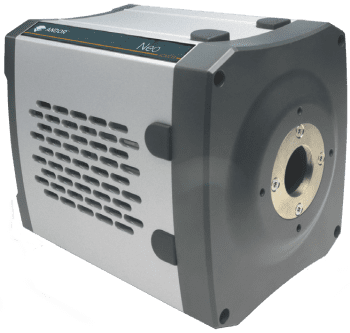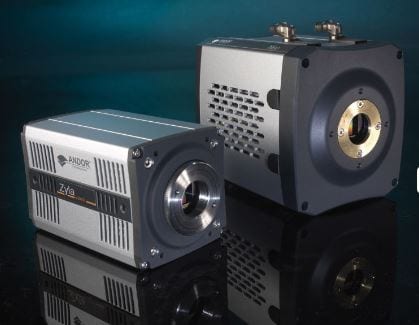

In a unique -40°C vacuum cooled platform, loaded with FPGA intelligence, Andor’s Neo sCMOS camera platform is designed exclusively to drive lowest possible dark noise from this exciting and innovative technology development. Zyla 5.5 is built around a superb, low noise, large field of view 5.5 megapixel sensor, capable of both Rolling and Global Shutter exposure modes
Overview
In a -40°C vacuum cooled platform, with 1 e- read noise, very low darkcurrent, Rolling and Global Shutter, and loaded with FPGA intelligence, Andor’s Neo sCMOS camera is designed to drive optimal performance from this exciting and innovative new technology development.
The Neo 5.5 model is based around a large 5.5 megapixel sensor with 6.5 µm pixels and a 22mm diameter, ideal for applications such as cell microscopy, astronomy, digital pathology and high content screening. The Neo 5.5 can deliver 30 fps sustained or up to 100 fps burst to internal 4GB memory. Extremely low darkcurrent means Neo 5.5 is suited to a range of exposure conditions. The Rolling and Global shutter flexibility further enhances application flexibility, Global shutter in particular offering an ideal means to simply and efficiently synchronize the Neo with other ‘moving’ devices such as stages or light switching sources and eliminating the possibility of spatial distortion when imaging fast moving objects.
The Andor GPU Express library has been created to simplify and optimize data transfers from camera to a CUDA-enabled NVidia Graphical Processing Unit (GPU) card to facilitate accelerated GPU processing as part of the acquisition pipeline.
| Key Specifications | |||
|---|---|---|---|
| Sensor Type | Front Illuminated Scientific CMOS | ||
| Active Pixels | 2560 x 2160 (5.5 Megapixel) | ||
| Sensor Size | 16.6 x 14.0 mm (21.8 mm diagonal) | ||
| Pixel readout rate (MHz) | 560 (280 MHz x 2 sensor halves) 200 (100 MHz x 2 sensor halves) |
||
| Read Noise (e-) 200 MHz 560 MHz |
|
||
| Minimum temperature air cooled Minimum temperature coolant |
-30 °C -40 °C |
||
| Dark current, e-/pixel/sec @ -30°C @ -40°C |
0.015 0.007 |
||
| Data range | 12 bit & 16 bit | ||
| Peak Quantum Efficiency | 60% | ||
| Readout modes | Rolling Shutter and Global (Snapshot) Shutter | ||
| Internal memory buffer size | 4 GB | ||
| Maximum burst frame rates 2560 x 2160 (full frame) 128 x 128 ROI |
100 fps Rolling Shutter, 49 fps Global (Snapshot) Shutter 1,639 fps Rolling Shutter, 716 fps Global (Snapshot) Shutter |
||
| Pixel well depth (e-) | 30,000 | ||
| Features | Benefits |
|---|---|
| 1 e- read noise | Offers lower detection limit than any CCD. |
| TE cooling to -40° C | Minimization of dark current to maintain low noise advantage under all exposure conditions. Minimization of hot pixel blemishes meaning more useful pixels. Fan-off mode for vibration sensitive set-ups. |
| 5.5 megapixel sensor format and 6.5 μm pixels | Delivers extremely sharp resolution over a 22 mm diagonal field of view: Ideal for cell microscopy and astronomy. |
| Rolling and Global (Snapshot) shutter | Maximum exposure and readout flexibility across all applications. Snapshot for ‘interline CCD mode’ freeze frame capture of fast moving/changing events. |
| Sub-microsecond inter-frame gap | Global Shutter offers down to 100 ns inter-frame gap, ideal for PIV applications. |
| Rapid frame rates | 30 fps over extended kinetic series; Burst to memory at 100 fps full frame |
| UltraVac™ | Sustained vacuum integrity and unequalled cooling with 5 year warranty; complete sensor protection. |
| Dual-Gain Amplifiers | Maximum well depth and lowest noise simultaneously, affording extended dynamic range of 30,000:1 |
| GPU Express | Simplify and optimize data transfers from camera to Graphical Processing Unit (GPU) card to facilitate accelerated GPU processing as part of the acquisition pipeline. |
| 4 GB on-head image buffer | enables bursts of 100 fps @ full dynamic range. Capture extended kinetic series faster than PC write speed, avoiding prohibitively expensive PCs. |
| Extensive FPGA on-head data processing | Essential to ensure best image quality and quantitative fidelity from sCMOS technology. |
| Hardware Timestamp | FPGA generated timestamp with 25ns accuracy. |
| Dynamic Baseline Clamp | Essential to ensure quantitative accuracy across the image area and between successive images of a kinetic series. |
| Spurious Noise Filter | Real time FPGA filter that identifies and compensates for spurious high noise pixels. |
| Single window design | Single input window with double AR coating ensures maximum photon throughput. |
| Data flow monitor | Innovatively manage acquisition capture rates vs data bandwidth limitations. |
| iCam | Market leading exposure switching with minimal overheads. |
| Comprehensive trigger modes & I/O | Communication and synchronization within intricate experimental set-ups. |
| Cameralink | Cameralink interface permits high bandwidth data spooling to PC, allowing fast continuous kinetic series. |
The Andor Learning Center hosts a wide range of case studies, technical articles and webinars to guide you through the many features of our portfolio.